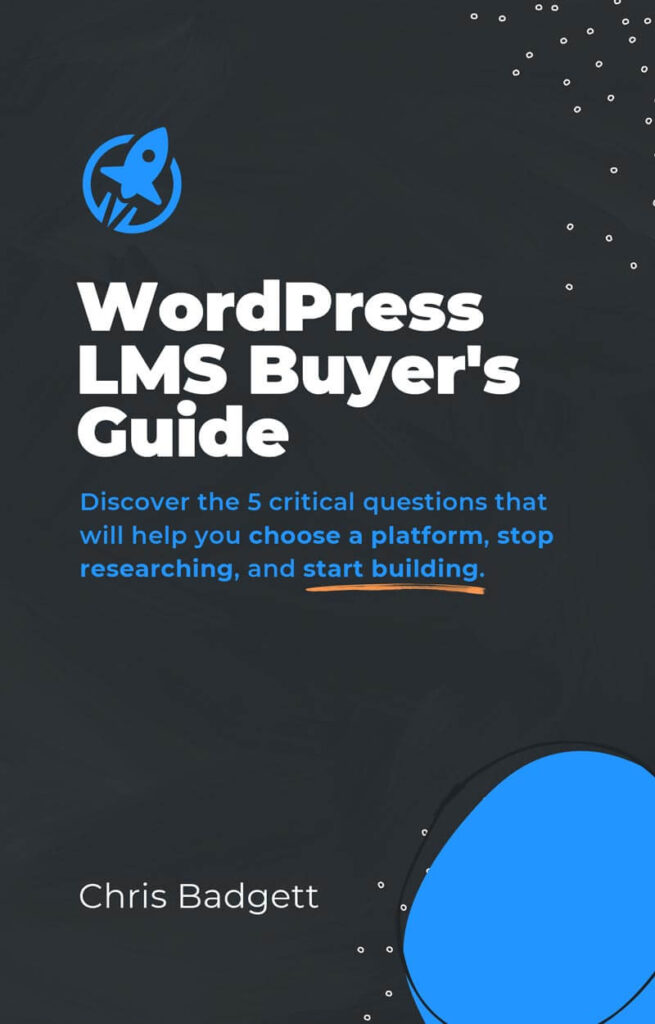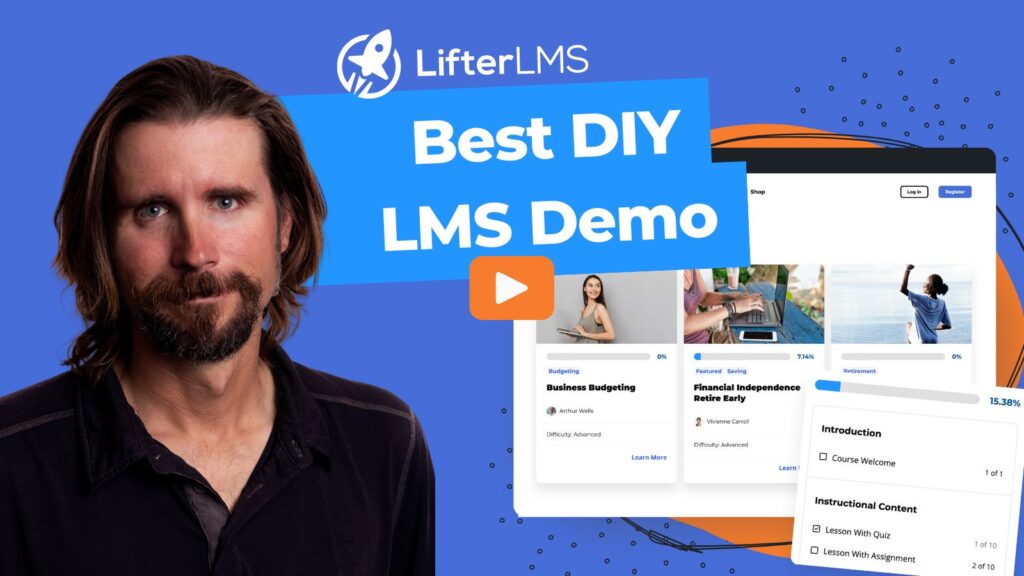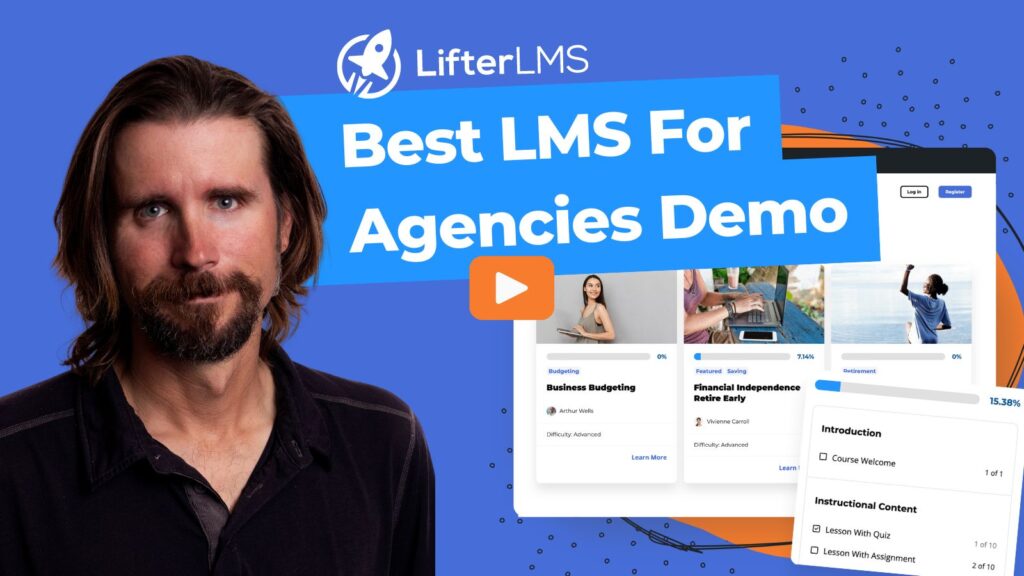The team at LifterLMS reached out to thought leaders from around the internet to weigh in on what you should consider when creating your online course. Avoid these mistakes …
John Lee Dumas
Audio Player
 “Hey, this is John Lee Dumas the founder and host of EntrepreneurOnFire, and I want to share with you today the number one mistake to avoid when creating an online course. And you better believe I have made this mistake more than once, I’m a little ashamed to admit. Make sure that you have a starving audience for that online course. The only way that you can verify that the audience is starving is if they actually pull out their wallet and pay for a preview version of that course, or locking down early access to that course, or getting a discount for the future release of that course. If people are not willing to do that, then your audience is not starving enough to purchase in the quantities that you’re going to want them to when the course is actually created.
“Hey, this is John Lee Dumas the founder and host of EntrepreneurOnFire, and I want to share with you today the number one mistake to avoid when creating an online course. And you better believe I have made this mistake more than once, I’m a little ashamed to admit. Make sure that you have a starving audience for that online course. The only way that you can verify that the audience is starving is if they actually pull out their wallet and pay for a preview version of that course, or locking down early access to that course, or getting a discount for the future release of that course. If people are not willing to do that, then your audience is not starving enough to purchase in the quantities that you’re going to want them to when the course is actually created.So for both Podcasters’ Paradise and Webinar on Fire, we held live webinars explaining what the course would be when we released it down the road, and if you want to be an early bird, you can lock it in right now. And guess what? You’ll get a great discount to boot. Those presales ensured that we had a starving audience so that when we put our heads down for the next 30 to 45 days to create the content, we knew that there were dollars at the end of that road for our hard work. For the time, effort, and energy we were putting in.
So get that starving audience, get presales by actually talking to your avatars, that perfect client, and having them pull out their wallets and pay for something that hasn’t been created yet. It’s a tough ask, but it’s a lot tougher to flop and to get no sales. Believe me, I’ve been there, done that. Do this, and you’ll be prepared to ignite!”
John Lee Dumas is the founder and host of EntrepreneurOnFire, a podcast providing daily interviews with today’s most successful and inspiring entrepreneurs. He’s also the founder of Podcasters’ Paradise and WebinarOnFire.
Yaro Starak
 “The number one mistake I see when creating a course is working hard to create a program upfront, without knowing whether there are any people who want to buy it. In particular I find that course teachers are good at teaching, and not marketing, hence they are not aware of the best message to use to present their course to the audience. Sometimes just tweaking the message can make all the differences between no sales and a profitable course.”
“The number one mistake I see when creating a course is working hard to create a program upfront, without knowing whether there are any people who want to buy it. In particular I find that course teachers are good at teaching, and not marketing, hence they are not aware of the best message to use to present their course to the audience. Sometimes just tweaking the message can make all the differences between no sales and a profitable course.”
Yaro Starak is the author of the Blog Profits Blueprint and founder of the Entrepreneurs-Journey.com blog. He began blogging over ten years ago and has mentored thousands of other experts, authors, coaches, consultants, speakers and trainers on how to turn their expertise into a profitable online business.
Andrew Warner
 “The big mistake is not asking potential customers what they want to learn before you create. After I recorded my 1,000th interview, I decided to create a course on how to build an interview-based business. From the questions I read online, I assumed the biggest issue people had was figuring out how to record. You know, the right mic, software, etc.
“The big mistake is not asking potential customers what they want to learn before you create. After I recorded my 1,000th interview, I decided to create a course on how to build an interview-based business. From the questions I read online, I assumed the biggest issue people had was figuring out how to record. You know, the right mic, software, etc.
When I checked with my audience, they told me that they know that stuff, or could Google it, but what they were really struggling with is how to make an interview interesting. Until I asked them, I forgot how story structure and finding the right questions used to be tough for me. So I added a whole module to my course on structure. It’s one of the biggest reasons people ended up buying my course.”
Andrew Warner is the founder of Mixergy, a site where successful people teach ambitious upstarts.
Chris Ducker
 “The biggest mistake you can make when creating and selling a course online is to do so without asking your audience what they need help with. Whether it be a blog post you publish asking for comments and feedback, or a full blown survey, you simply MUST get feedback from your audience on their pain points and struggles, so that you can create the solution to those problems for them – otherwise you could be wasting your time.
“The biggest mistake you can make when creating and selling a course online is to do so without asking your audience what they need help with. Whether it be a blog post you publish asking for comments and feedback, or a full blown survey, you simply MUST get feedback from your audience on their pain points and struggles, so that you can create the solution to those problems for them – otherwise you could be wasting your time.
You could even go one step further (after getting the feedback) and create a landing page for the course as a ‘pre-launch’ offer, and sell the course idea to your audience before investing a minute of time – actually building out the course itself. In the infomercial world, they call this ‘dry-testing’ and it’s helped save millions of dollars in manufacturing costs for hundreds of companies selling on TV, as they’ve been able to see that ‘the next big idea’ wasn’t so big after all.
Bottom line – create a course that solves a problem for your audience. They’ll thank you for it… by spending money with you!”
Chris Ducker is a serial entrepreneur, speaker, blogger, and podcaster. He is the author of #1 bestseller Virtual Freedom and the founder of Virtual Staff Finder.
Scott Dinsmore
 “The biggest mistake is to create something you think your audience needs instead of creating something you KNOW they need. That is the most incredible thing about our audience and community based businesses. We get to ask them exactly what they most need help with (their biggest pains, fears, and challenges), and then we get to create exactly what they need. That way when we sell it to them later on, we can be certain we have the fit right and that it’s something that’s actually going to help people. And that all but guarantees the product, course, and launch will be successful. It’s so easy to assume you know what people want – the only problem is you’ll be wrong (or at least not completely right). But do the work early on of nailing exactly where your community needs the most help and support, and both sides will likely be a ton more successful (and much happier!).
“The biggest mistake is to create something you think your audience needs instead of creating something you KNOW they need. That is the most incredible thing about our audience and community based businesses. We get to ask them exactly what they most need help with (their biggest pains, fears, and challenges), and then we get to create exactly what they need. That way when we sell it to them later on, we can be certain we have the fit right and that it’s something that’s actually going to help people. And that all but guarantees the product, course, and launch will be successful. It’s so easy to assume you know what people want – the only problem is you’ll be wrong (or at least not completely right). But do the work early on of nailing exactly where your community needs the most help and support, and both sides will likely be a ton more successful (and much happier!).
The days of Design, Build, then Sell are over. Now we get to Sell first (by asking them directly about their pain), then go on to Design and Build something we’re certain they want and need.
That has changed everything for us at Live Your Legend and our ability to help our community and build a big, sustainable, and growing business.”
Scott Dinsmore is an entrepreneur, writer, husband, and founder of Live Your Legend, where he helps people around the world find and do work they love. In 2012, Scott gave a TEDx talk, which has become one of the top 15 most viewed TEDx talks of the 35,000+ talks on YouTube.
James Schramko
 “The most common mistake when people create online courses is focusing too much on ‘stuff’ and not enough on the customer getting ‘results’.”
“The most common mistake when people create online courses is focusing too much on ‘stuff’ and not enough on the customer getting ‘results’.”
James Schramko is the founder of SuperFastBusiness, where he provides tips, videos, and podcasts to help entrepreneurs with traffic, websites, and business coaching so they can grow successful businesses on the internet.
Corbett Barr
 “The #1 mistake is making a course that is boring or useless, or both.”
“The #1 mistake is making a course that is boring or useless, or both.”
Corbett Barr is a blogger, podcaster, and CEO of Fizzle, where people working to become self-employed on the web go for training, community, and support.
Caleb Wojcik
 “The number one mistake I made was not involving my audience in the creation of the course the first time I launched one. I worked in secret for months and then released it.
“The number one mistake I made was not involving my audience in the creation of the course the first time I launched one. I worked in secret for months and then released it.
The second time around I surveyed my audience, teased what was coming, and shared the release date early. Don’t work in a vacuum. Share what you’re doing and give your audience time to decide whether they want to buy your course before it even goes on sale.”
Caleb Wojcik teaches web creatives how to make better videos at DIYVideoGuy.com & runs a video production studio at CalebWojcikFilms.com. (He previously cofounded Fizzle.co).
Pat Flynn
 “When creating an online course, don’t forget about the user experience and navigation through your content. It can be hard to understand truly what the experience is like on your end since you’re the one creating your course, so have a few special people in your audience, or maybe a couple of friends of yours go through what you’ve setup to give you honest feedback on their experience. Have them pay attention to how easy (or not) easy it is to get started immediately after entering the course, switching between lessons, understanding progression through the coursework, and always ask ‘what’s missing’.”
“When creating an online course, don’t forget about the user experience and navigation through your content. It can be hard to understand truly what the experience is like on your end since you’re the one creating your course, so have a few special people in your audience, or maybe a couple of friends of yours go through what you’ve setup to give you honest feedback on their experience. Have them pay attention to how easy (or not) easy it is to get started immediately after entering the course, switching between lessons, understanding progression through the coursework, and always ask ‘what’s missing’.”
Pat Flynn is a father, husband, and multiple business owner who shares his business wins and failures over at SmartPassiveIncome.com.
Tim Paige
 “The number one mistake to avoid is creating a course before knowing if you’re solving a problem people are willing to pay for. Figure that out first, and then create the course around the problem.”
“The number one mistake to avoid is creating a course before knowing if you’re solving a problem people are willing to pay for. Figure that out first, and then create the course around the problem.”
Tim Paige is proud to be the Conversion Educator at LeadPages. You may recognize Tim’s voice from the dozens of webinars he has hosted at LeadPages or from LeadPages official podcast, ConversionCast.
Matt Medeiros
 “First and foremost, underestimating the amount of time it takes to create a quality course is something I see time and time again. It’s very easy for a lot of web marketing pros to give out this kind of advice, but a lot harder for someone to put in the work.
“First and foremost, underestimating the amount of time it takes to create a quality course is something I see time and time again. It’s very easy for a lot of web marketing pros to give out this kind of advice, but a lot harder for someone to put in the work.
On that note, people take on more than they can chew. Some of the best courses I’ve seen are for the simplest of tasks — but executed really well. Don’t feel the need to cram in a boat load of content, just for the sake of extending the page count or minutes in a video — focus on quality actionable advice.”
Matt Medeiros is the host of The Matt Report, a digital business podcast, and he’s the creator of ConductorPlugin.com, a tool for making it easy to display content & unique layouts in WordPress.
Terry Lin
 “In my view the #1 mistake is creating modules that are too long, i.e. over 15 minutes. Anything longer than that and I believe you start to lose the attention and focus of the customer. As a content creator you want to pack as much value as possible, but total time isn’t the best indicator of that – especially in this day and age with so many distractions. A great concept I picked up from minimalist industrial design is to remove product features until it breaks. Just before the breaking point where it loses its function and purpose is the place you want to be.”
“In my view the #1 mistake is creating modules that are too long, i.e. over 15 minutes. Anything longer than that and I believe you start to lose the attention and focus of the customer. As a content creator you want to pack as much value as possible, but total time isn’t the best indicator of that – especially in this day and age with so many distractions. A great concept I picked up from minimalist industrial design is to remove product features until it breaks. Just before the breaking point where it loses its function and purpose is the place you want to be.”
Terry Lin is the founder and co-host of Build My Online Store, an e-Commerce podcast that helps entrepreneurs grow their online business. He also runs an accessories store at BallerLeather.com.
Troy Dean
 “The number one mistake to avoid when creating an online course is making the assumption that anyone will give a shit. Create a course that people want to buy instead of creating a course and then trying to sell it.”
“The number one mistake to avoid when creating an online course is making the assumption that anyone will give a shit. Create a course that people want to buy instead of creating a course and then trying to sell it.”
Troy Dean is an online marketing speaker, coach, and consultant who specializes in helping businesses and entrepreneurs use the internet to attract new customers and build their communities. Find out more at TroyDean.com.au.
Natalie Sisson
 “You should not forsake the quality of the content and the learning outcomes in order to create something that ‘looks’ pretty and professional. While people do judge based on your program’s look and feel during a launch, at the end of the day, if you focus on getting them great results they will love you forever. For my flagship program’s launch I worked with an educational strategist to uncover the levels of mastery my students would go through to make real progress and take daily action. The result was incredible with a lot of happy lifelong members. I’ve seen some very simple online courses with great content that have been a huge success too, so focus on quality content and delivery always.”
“You should not forsake the quality of the content and the learning outcomes in order to create something that ‘looks’ pretty and professional. While people do judge based on your program’s look and feel during a launch, at the end of the day, if you focus on getting them great results they will love you forever. For my flagship program’s launch I worked with an educational strategist to uncover the levels of mastery my students would go through to make real progress and take daily action. The result was incredible with a lot of happy lifelong members. I’ve seen some very simple online courses with great content that have been a huge success too, so focus on quality content and delivery always.”
Natalie Sisson is a Suitcase Entrepreneur, bestselling author, podcaster, speaker, business design coach, and adventurer who travels the world living out of her suitcase. She runs a highly successful online business from her laptop and smartphone, and teaches others how to build an online business and lifestyle they love, on their own terms.
Chris Coyier
 “This certainly isn’t the #1 mistake you can make, but this one is unique to how I approach training videos. I don’t cover up mistakes. If I make a TON of mistakes and the whole thing goes to crap, I’ll just stop, junk it, and try again. But if there is a hiccup, I’ll leave that in there and troubleshoot it on the spot. It’s not comfortable, but from the feedback I get, people appreciate the honesty, learn from the troubleshooting steps, and engage in the drama of it all. You’ll get the occasional jerk who tells tries to tell you that’s annoying and to stop, but those people are likely trying to “find info fast” and are frustrated. Video is better for a more passive learner. That jerk has probably found a blog post solving their problem anyway.”
“This certainly isn’t the #1 mistake you can make, but this one is unique to how I approach training videos. I don’t cover up mistakes. If I make a TON of mistakes and the whole thing goes to crap, I’ll just stop, junk it, and try again. But if there is a hiccup, I’ll leave that in there and troubleshoot it on the spot. It’s not comfortable, but from the feedback I get, people appreciate the honesty, learn from the troubleshooting steps, and engage in the drama of it all. You’ll get the occasional jerk who tells tries to tell you that’s annoying and to stop, but those people are likely trying to “find info fast” and are frustrated. Video is better for a more passive learner. That jerk has probably found a blog post solving their problem anyway.”
Chris Coyier is the founder of CSS-Tricks, one of the cofounders of CodePen, and a podcaster at ShopTalk.
Chris Guillebeau
 “The biggest mistake I see is people not making a course that’s truly marketable and “wanted” by consumers. They think they have a great idea and they put a lot of work into it—but they don’t take the time to validate the need and ensure they’re creating something that meets a clear need. Spending time on that process, more than any investment in technology, is critical before going into hustle mode.”
“The biggest mistake I see is people not making a course that’s truly marketable and “wanted” by consumers. They think they have a great idea and they put a lot of work into it—but they don’t take the time to validate the need and ensure they’re creating something that meets a clear need. Spending time on that process, more than any investment in technology, is critical before going into hustle mode.”
Chris Guillebeau is the New York Times bestselling author of The Happiness of Pursuit (out now!) & The $100 Startup. He visited every country in the world from 2002-2013 and is still traveling. Every summer in Portland, Oregon, Chris hosts the World Domination Summit, a gathering of creative, remarkable people with thousands in attendance. Chris is also the founder of Pioneer Nation, Unconventional Guides, the Travel Hacking Cartel, and numerous other projects.
Jonathan Mizel
 “The most important thing we consider when creating any sort of training, online or off-line, is to know the audience who will be consuming the material. We recommend creating a detailed avatar, or customer persona, including age, gender, skillset, and all the other demographic stuff that determines how they learn and more importantly, the context from which they approach the material.
“The most important thing we consider when creating any sort of training, online or off-line, is to know the audience who will be consuming the material. We recommend creating a detailed avatar, or customer persona, including age, gender, skillset, and all the other demographic stuff that determines how they learn and more importantly, the context from which they approach the material.
In other words, know your customer, and realize what they want to achieve as well as their current limitations. I’ve seen many people sell courses that assume the buyer will have certain knowledge or abilities. This is especially true in the IM niche, and particularly with newbie products.
On the other hand, if you’re selling to a more advanced user, get to the point quickly, and remember, nobody needs another 20+ hour course. Shorter is better, impactful lessons that are a few pages are far superior to long-drawn out videos or audios filled with fluff.”
Jonathan Mizel is the creator of the Traffic Evolution training, the #1 online course that reveals how to get massive traffic to any website with media buys. You can visit TrafficEvolution.com for details.
Joshua Millage
 “Think through how you will engage with your students after they purchase your course. Sales are important, but so many eduprenuers forget about the student post-purchase. Focus on getting your students to learn and the sales will take care of themselves.”
“Think through how you will engage with your students after they purchase your course. Sales are important, but so many eduprenuers forget about the student post-purchase. Focus on getting your students to learn and the sales will take care of themselves.”
Joshua Millage is the cofounder of LifterLMS, a platform that helps you develop online courses with WordPress. He is the CEO and cofounder of codeBOX, the premier web development shop for Infusionsoft users. Joshua cohosts a podcast with Chris Badgett for the education entrepreneur community at LMScast, and he hosts a podcast for the Infusionsoft community at Infusioncast.
Chris Badgett
 “The number 1 mistake to avoid when creating an online course, especially your first online course, is to focus too much on the technology for delivering and possibly selling your course.
“The number 1 mistake to avoid when creating an online course, especially your first online course, is to focus too much on the technology for delivering and possibly selling your course.
Great life-changing, skill-enhancing courses are much more important than the technology for delivering them. Make sure your courses solve real problems for a specific groups of people. Focus on that first; then focus on the technology.
I’ve also made a video about the top mistakes we’ve seen people building a WordPress powered learning management system make. Click here to check that out.”
Chris Badgett cohosts a podcast with Joshua Millage for the education entrepreneur community over at LMScast. He is also a cocreator with the codeBOX crew of the LifterLMS WordPress learning management system plugin.
Thomas Patrick Levy
 “I don’t create online courses but I’ve taken a few, so I’ll speak to what personally aggravates me or turns me off from an online course. Videos are the worst way to learn in my opinion. Of course I think this depends on the discipline and user. I read a lot of development tutorials and I just can’t focus on a video, I want to interact with the code snippets and take my time reading and testing pieces as I go. Every development course in video form I have ever taken I have stopped before the end of the first lesson. So if you’re teaching people anything with code, I’d recommend using text and images.”
“I don’t create online courses but I’ve taken a few, so I’ll speak to what personally aggravates me or turns me off from an online course. Videos are the worst way to learn in my opinion. Of course I think this depends on the discipline and user. I read a lot of development tutorials and I just can’t focus on a video, I want to interact with the code snippets and take my time reading and testing pieces as I go. Every development course in video form I have ever taken I have stopped before the end of the first lesson. So if you’re teaching people anything with code, I’d recommend using text and images.”
Thomas Patrick Levy is the cofounder of codeBOX, the premier web development shop for Infusionsoft users, and he is a cocreator of the LifterLMS WordPress learning management system plugin. He is also a poet at ThomasPatrickLevy.com.
Mark Nelson
 “Preparation. The #1 mistake you can make when creating an online course is a lack of preparation.
“Preparation. The #1 mistake you can make when creating an online course is a lack of preparation.
Before you ever start creating any content for your course you need to create an outline of the course objectives. Start by writing down the main goal of the course. Break that goal into main topics. Break the main topics into smaller sub topics. Your sub topics should be relative to the main topics and your main topics should support the goal of the course.
When you are creating a course outline, KISS it ( keep it simple stupid ). It’s a single course. Don’t try to cover too much. If you have 10 main topics and 30 sub topics then your course goal might be too broad. You can always create two courses. I see a lot of courses like “Learn Javascript” or “How to make money online.” Those topics are huge and no single course can really meet that expectation.
A great online course has a single goal and spends all the lessons helping the user meet that goal. Authors of great courses always prepare ahead of time. If you want your course to succeed my advice is prepare.”
Mark Nelson is a web developer at codeBOX and lead developer of the LifterLMS plugin. Mark wants to build a better learning management system so he can take better courses. He has a twitter account @marknelsondev.
Kathy Gilchrist
 “The biggest mistake I see repeatedly in online courses is not making the course materials interesting and easy for the student to consume. This can be due to a boring delivery style, videos that are too long, a difficult user interface, or not offering the course materials in multimedia formats in order to meet the needs of people with different learning styles. The best online courses are educational as well as engaging and easy to use.”
“The biggest mistake I see repeatedly in online courses is not making the course materials interesting and easy for the student to consume. This can be due to a boring delivery style, videos that are too long, a difficult user interface, or not offering the course materials in multimedia formats in order to meet the needs of people with different learning styles. The best online courses are educational as well as engaging and easy to use.”
Kathy Gilchrist is a member of the codeBOX and LifterLMS crew and an avid online learner.





